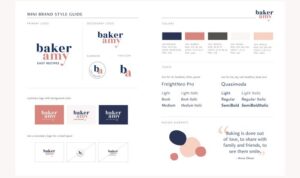Building Brand Consistency Across Platforms dives into the essential strategies for creating a cohesive brand presence that resonates with audiences across various channels. From defining a brand style guide to maintaining a consistent tone of voice, this topic explores the key elements that contribute to a successful brand identity in the digital age.
As businesses strive to stand out in a crowded marketplace, understanding the significance of brand consistency and implementing effective strategies is paramount to building long-lasting customer relationships and fostering brand loyalty.
Importance of Brand Consistency

Maintaining brand consistency across platforms is crucial for establishing a strong and recognizable brand identity. Consistency helps build trust with customers, creates a sense of reliability, and reinforces brand values. When customers encounter consistent branding, they are more likely to remember and engage with the brand, leading to increased brand loyalty and customer retention.
Examples of Successful Brands
- Apple: Apple is a prime example of a brand that has maintained consistent branding across all its products and marketing channels. From their sleek design aesthetic to their minimalist advertising campaigns, Apple’s brand identity is instantly recognizable.
- Coca-Cola: Coca-Cola’s iconic red and white logo has remained unchanged for decades, creating a sense of nostalgia and trust among consumers. Their messaging and branding elements are consistent across all platforms, reinforcing their brand image.
- Nike: Nike’s “Just Do It” slogan and swoosh logo are consistent features in all their marketing efforts. This consistency has helped Nike become one of the most recognizable and successful brands in the world.
Impact of Inconsistent Branding
Inconsistent branding can confuse customers, dilute brand messaging, and erode brand trust. When customers encounter different brand identities across platforms, they may become skeptical of the brand’s authenticity and reliability. This can lead to a lack of trust, decreased customer loyalty, and ultimately, a negative impact on the brand’s reputation and bottom line.
Building a Brand Style Guide

Creating a brand style guide is essential for maintaining consistency across platforms and ensuring that your brand message is effectively communicated to your audience. A brand style guide serves as a blueprint for how your brand should look, sound, and feel, providing clear guidelines for all brand-related materials.
Elements of a Brand Style Guide
- Brand Identity: Include your logo, colors, typography, and any other visual elements that make up your brand’s identity.
- Voice and Tone: Define the personality of your brand through guidelines on language, style, and communication approach.
- Messaging: Artikel key messages, taglines, and brand stories that should be consistently conveyed across all platforms.
- Design Principles: Establish rules for layout, imagery, and overall design aesthetic to ensure a cohesive brand image.
- Usage Guidelines: Provide instructions on how to correctly use brand assets and maintain brand integrity.
Benefits of a Brand Style Guide
A brand style guide helps in maintaining consistency across platforms by ensuring that all brand-related materials adhere to the same visual and verbal standards. It helps in creating a unified brand image and enhances brand recognition among your target audience. With a brand style guide in place, you can easily align all marketing efforts and communication strategies to reinforce your brand identity.
Tips for Creating an Effective Brand Style Guide
- Research and Understand Your Audience: Tailor your brand style guide to resonate with your target demographic.
- Collaborate with Key Stakeholders: Involve key team members in the development of the brand style guide to ensure buy-in and consistency.
- Be Clear and Concise: Provide detailed guidelines that are easy to understand and follow.
- Regularly Update and Review: Keep your brand style guide current to adapt to changing trends and audience preferences.
- Train Your Team: Educate your team members on the brand style guide and ensure they understand the importance of consistency.
Implementing Consistent Visual Identity: Building Brand Consistency Across Platforms
Visual elements play a crucial role in maintaining brand consistency across different platforms. Consistency in visual identity helps in creating a strong brand image, increasing brand recognition, and building trust among customers. It is essential for a brand to have a cohesive look and feel that is easily recognizable by its target audience.
The Importance of Visual Elements
Visual elements such as logos, color schemes, typography, and imagery are key components of a brand’s visual identity. These elements help in conveying the brand’s personality, values, and messaging to the audience. Consistency in these visual elements ensures that the brand is portrayed in a uniform manner across all touchpoints, whether it’s a website, social media, packaging, or advertising.
- Use a consistent color palette: Choose a set of colors that represent your brand and use them consistently across all platforms.
- Design a unique logo: Your logo is the face of your brand, so make sure it is prominently displayed and consistent in its appearance.
- Maintain consistent typography: Select fonts that reflect your brand’s tone and style, and use them consistently in all communications.
- Create a cohesive imagery style: Develop a visual language that aligns with your brand values and use it consistently in your visuals.
Examples of Brands with Effective Visual Consistency, Building Brand Consistency Across Platforms
One brand that excels in maintaining visual consistency is Apple. From their sleek logo to their minimalist product design, Apple’s visual identity is instantly recognizable and consistent across all their products and marketing materials. Another example is Coca-Cola, with its iconic red and white color scheme and distinctive typography that have remained consistent for decades, helping the brand establish a strong visual presence globally.
Tone of Voice and Messaging Consistency
Maintaining a consistent tone of voice in branding is crucial for creating a strong and recognizable identity for your brand. It helps in establishing a connection with your audience and conveying a specific personality that sets you apart from competitors.
Significance of Consistent Tone of Voice
Consistency in tone of voice ensures that all communication, whether it’s on social media, website content, or marketing materials, reflects the same brand personality. This helps in building trust and loyalty among customers, as they know what to expect from your brand.
Messaging Consistency for Brand Identity
When your messaging is consistent across all platforms, it reinforces your brand identity and values. It helps in creating a cohesive brand image that resonates with your target audience and makes your brand more memorable.
Tips for Ensuring Uniformity
- Develop a brand style guide that includes guidelines for tone of voice, messaging, and brand values.
- Train your team members on the importance of maintaining a consistent tone of voice in all communications.
- Regularly review and update your brand style guide to adapt to changes in the market and audience preferences.
- Use feedback from customers to refine your messaging and ensure it aligns with their expectations.
- Audit your content across platforms to identify any inconsistencies and make necessary adjustments.












